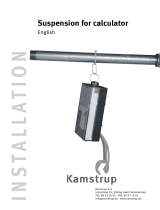
Quick Start Guide
FLEX ARRAY
FLEX ARRAY Quick Start Guide - Page - 3
SAFETY INFORMATION
Safety Notes on Rigging
The Turbosound rigging system has been designed and constructed to a high standard of safety,
and tested to the most demanding of specifications. In order to ensure the highest safety standards,
the information following on the assembly and safe use of rigging accessories must be carefully
understood and followed.
Only use Turbosound recommended rigging accessories, which are specifically designed for their intended
purpose. Do not use Turbosound rigging with other types or brands of loudspeakers. This practice may
compromise safety standards and Turbosound will not be responsible for damage or injury so caused. Do not
modify the rigging accessories, or use them in a way other than that described in this user manual. Rigging
components supplied as part of a complete assembly are non-interchangeable and must not be exchanged with
the component parts of any other assembly. The component parts of a Turbosound rigging accessory must only
be assembled using the fasteners and methods of assembly recommended in this guide. The use of fasteners and
methods of assembly not specified or approved by Turbosound may result in an unsafe rigging assembly.
Welding, or any other means of permanently fixing rigging components to each other or to cabinet fixing points is
not allowed. Rigging assemblies must only be assembled using the appropriate parts and fixings as specified in
this manual using the specific mounting instructions. Rigging components or assemblies must only be fixed to
Turbosound loudspeaker cabinets using the cabinet fixing points, assembly methods and fasteners specified in
this guide and the specific mounting instructions.
Secondary Safeties
All loudspeakers flown in theatres, studios or other places of work and entertainment must, in addition to the
principle load bearing means of suspension, be provided with an independent, properly rated and securely
attached secondary safety. Only steel wire ropes or steel chains of an approved construction and load rating may
be used as secondary safeties. Plastic covered steel wire ropes are not permitted for use as secondary safeties.
Safety Inspections
Carefully inspect rigging systems components and cabinets for defects or signs of damage before
proceeding to assemble a flown array. If any parts are damaged or suspect, DO NOT USE THEM.
Regular, more rigorous test and inspection of rigging components must also be carried out. Safety
legislation and test and inspection requirements will vary from country to country. In most cases, annual
independent test and inspection by a suitably approved and qualified inspector will be required. Users must
ensure compliance with all applicable safety requirements. Turbosound recommends regular safety inspections
and further recommends that a logbook be kept detailing the test and inspection history of each Turbosound
rigging accessory. Always wear protective headwear, footwear and eye protection in accordance with local
regulations. Anyone involved in flying ANY sound system should take note of the following advice:
The rigging of a flown sound system may be dangerous unless undertaken by qualified personnel with the
required experience and certification to perform the necessary tasks. Fixing of hanging points in a roof should
always be carried out by a professional rigger and in accordance with the local rules of the venue. The house
rigger and/or building manager must always be consulted.
Flying System components have been individually tested in accordance with the following regulations:












